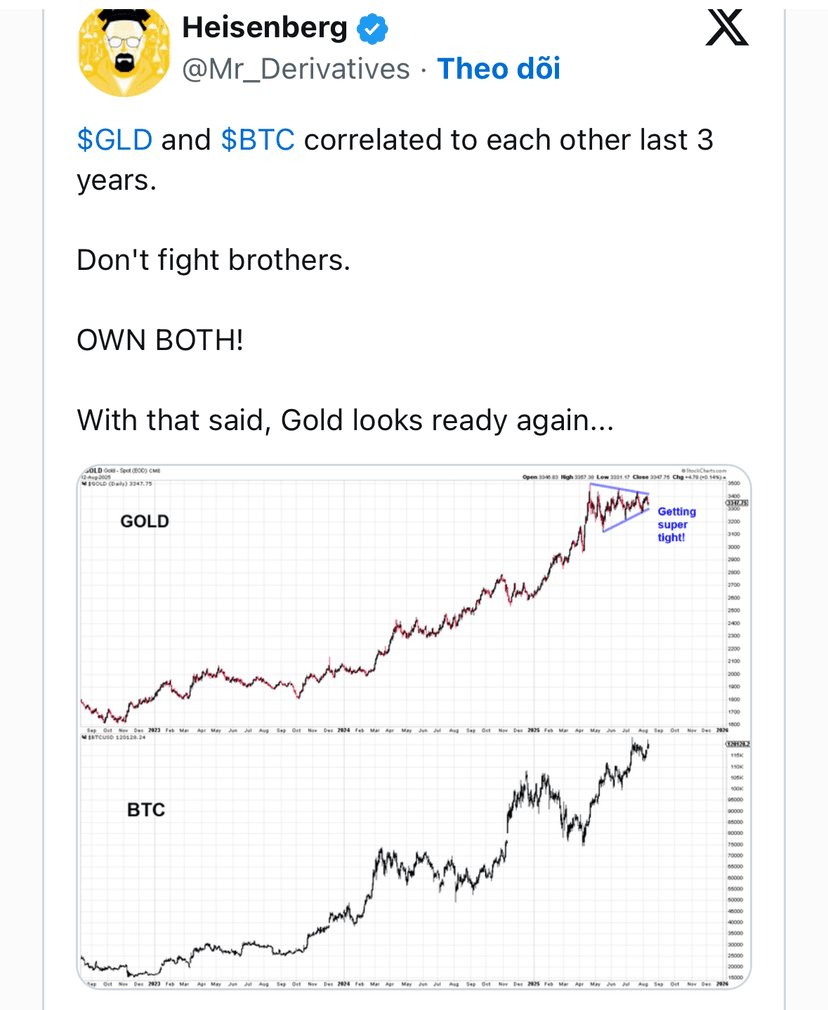Bitcoin (BTC) has reached a new historical peak of 123,700 USD during the Asian trading session this morning (August 14), igniting a wave of excitement throughout the crypto market.
Many experts believe that this strong growth of BTC is not yet over, with one of the main drivers being the positive correlation between Bitcoin and gold.
What lies ahead for Bitcoin?
In a recent post on X, Charles Edwards – founder of Capriole Investments – pointed out the growing gap between gold prices and Bitcoin prices. His analysis shows that Bitcoin tends to narrow this gap over time.
Edwards sees the current gap as similar to the period in 2020 – a time when Bitcoin entered an 'extraordinary' growth cycle.
Even by 2021, Bitcoin had outperformed gold. Therefore, if history repeats itself, the largest cryptocurrency in the market could continue its upward trend, surpassing the current record peak to establish new price milestones.
Cryptocurrency investor Jelle also agrees with this view, emphasizing that gold often serves as a 'leader' guiding Bitcoin prices. According to him, if this pattern continues, BTC could aim for the 150,000 USD mark – consistent with past trends.

Why could Bitcoin continue to rise?
Expectations for Bitcoin prices, or even gold, to continue rising are not far-fetched considering the current market context. Charlie Bilello – market strategy director at Creative Planning – stated that gold and Bitcoin are the two best-performing assets in 2025.
"Gold (+29%) and Bitcoin (+25%) are leading the list of major assets with the highest performance as of now in 2025."
He emphasized that it is rare for gold and Bitcoin to hold the top two positions in a year, making 2025 a notable exception. Additionally, in a series of posts on X, The Kobeissi Letter analyzed that both BTC and gold are benefiting from multiple macro factors.
Accordingly, in July 2025, total tariff revenues in the U.S. increased by more than 300%, reaching a record 29.6 billion USD. The Kobeissi Letter forecasts that this figure could exceed 350 billion USD per year during President Trump's term. However, the U.S. budget deficit also increased by 47 billion USD (19%) in July, reaching a record high of 630 billion USD in government spending. Tariff revenues only cover about 10% of this deficit.
"Even though tariff revenues reached a record high, the U.S. still spent nearly double the tax revenue in July. If spending is cut, President Trump's tariff policy could significantly help close the deficits. But for now, the gap remains too wide to fill," Kobeissi noted.
This economic context is driving demand for gold and Bitcoin, as investors seek safe-haven assets amid financial instability and inflationary pressures.
"As we have said for over 12 months, this is the best fundamental context for both gold and Bitcoin."
Additionally, the latest data from CME's FedWatch tool shows that the probability of the Fed cutting interest rates in September has skyrocketed to 95.8%.
According to analyses, if the Fed cuts interest rates, this would be a very positive factor for the cryptocurrency market. Therefore, the gold – BTC correlation along with other supportive macro factors indicates that Bitcoin's upward momentum still has much potential. The market will continue to watch closely to see how far BTC can go in the near future.